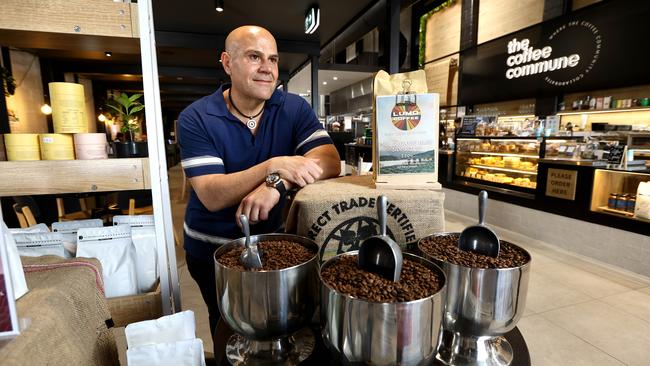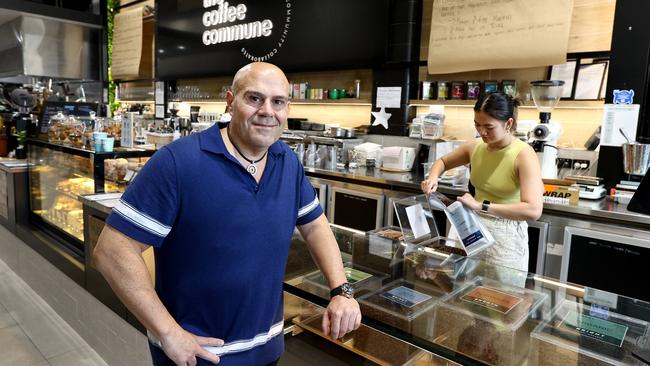Food and beverage sector feels brunt of business failures: CreditorWatch
Business failures in the hospitality sector have almost doubled over the past year and are tipped to climb further as costs mount, tax debts grow and consumers tighten their belts.

Business
Don't miss out on the headlines from Business. Followed categories will be added to My News.
The cost-of-living crisis has taken a large bite out of the food and beverage sector, with business failures now at the highest rate since the depths of Covid as consumers adjust their spending habits.
The food and beverage services sector recorded the highest failure rate of all industries in October, according to credit reporting bureau CreditorWatch’s latest Business Risk Index.
The index showed the average failure rate for Australian businesses overall at 5.04 per cent, up from 3.97 per cent in October last year. The previous high was 5.08 per cent in October 2020, when the pandemic was in full swing.
But the sector’s failure rate ballooned to 8.5 per cent in October on a rolling 12-month basis, from 8.3 per cent in the 12 months to September. CreditorWatch’s 12-month forecast is for the sector’s failure rate to hit 9.1 per cent.
Phillip Di Bella, founder of the Di Bella Coffee brand and The Coffee Commune in Brisbane, said the sector was under extreme pressure, warning that an average small flat white will hit the $6 mark, possibly on its way to $7.
“We’re doing it tough because disposable income is down and the expenses are up, so it’s causing mayhem,” he said.
“But we can’t charge at the same rate as our expenses go up. Electricity 12 months ago was around 23c a kilowatt and now it’s about 32c a kilowatt. That’s about a 40 per cent rise.”
Mr Di Bella it was important state and federal governments understood the impact of their decisions on the sector.
“It’s all about responsible management of money, which means they don’t have to keep putting new costs and regulations on businesses,” he said.
CreditorWatch chief economist Ivan Colhoun said businesses had many of the same cost pressures as consumers, such as higher electricity, insurance and rental costs, as well as the impacts of minimum wage increases.
“Together with some greater caution in discretionary spending and softness in interest rate-sensitive sectors of the economy, this unsurprisingly has led to higher voluntary business closures and some rise in insolvencies,” he said.
“We’re yet to see the extent to which the 1 July tax cuts now flowing through the economy will ease some of the pressures on consumers and businesses.

“Pleasingly, the unemployment rate remains very low at 4.1 per cent. Consumer confidence readings have risen notably from very low levels … business confidence also rose in October and business conditions are around long-term averages, according to the NAB Business Survey.”
Adding to the hospitality sector’s pain, the latest CommBank iQ Cost of Living Insights report found that cost-conscious younger people are increasingly forgoing eating out in favour of food delivery services.
CommBank iQ head of innovation and analytics Wade Tubman said Australians were “adjusting their wallets”.
“Younger people are cutting back. They are still making sacrifices as they face lingering cost pressures. Many are eating out less and buying fewer clothes while prioritising in-home entertainment like streaming.
“In fact we’ve seen those all the way up to 40 years old cut back on spending, highlighting the large swath of the population feeling cost-of-living pressure.”
Overdue tax debts are among the biggest burdens on businesses. According to the ATO, food and beverage services is the leading industry for outstanding tax debts, with 1.84 per cent of companies owing more than $100,000.
Construction and transport, and postal and warehousing are next at 1.28 per cent and 0.97 per cent of businesses, respectively.

CreditorWatch said it now has 28,780 records of businesses with overdue tax debts of more than $100,000, with sole traders comprising 14,216 or 49.4 per cent.
Australian Retail Association chief industry affairs officer Fleur Brown said retailers have faced a permanent state of disruption since the pandemic.
“This year pressures have intensified with slowed consumer spending coupled with increased costs of doing business,” she saud..
“Any business failure is a loss to the industry, and it is sad to see some well established businesses struggling to survive in this challenging year. Small businesses can be more vulnerable to cashflow challenges - with less of a buffer in place to withstand tough times.
“The ARA continues to call for interest rate relief from the RBA to help the sustainability of the sector.”
According to Australian Securities and Investments Commission data, there have been 5194 insolvency appointments across all industries for the financial year to November 3, including 947 in the accommodation and food services sector and 1280 in construction-related businesses.
But, while construction failures have risen 23 per cent compared to the same four months last financial year, accommodation and food service collapses have almost doubled to 92 per cent, up from 494 a year ago and 338 in the 2023 financial year.
WTC Advisory partner Andrew Weatherley said ASIC’s latest statistics, released on November 11, were “concerning”.
“They reveal a 73.5 per cent increase in insolvency appointments in October 2024 compared to the previous corresponding period, and a 19.9 per cent increase from September 2024,” he said. “In our experience, the main catalyst for directors taking action … is in response to the ATO’s efforts to recover outstanding liabilities. We expect this to continue.”
Administrative and support services ranked second at 6 per cent of failures on CreditorWatch’s October Business Risk Index, followed by arts and recreation services (5.9 per cent) and transport, postal and warehousing (5.8 per cent).
Originally published as Food and beverage sector feels brunt of business failures: CreditorWatch



